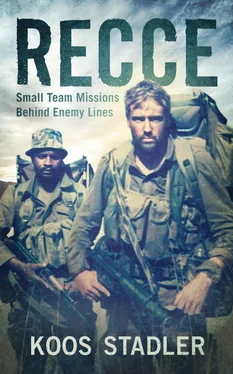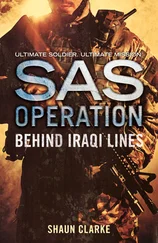As a tactical reconnaissance capability, the 31 Battalion recces were in high demand for intelligence collection missions in the areas of responsibility of sectors 20 (Rundu) and 70 (Katima Mulilo). Our mission was to locate enemy bases and installations in the “near” areas, up to a distance of roughly 60 km across the border, while the Reconnaissance Commandos were supposed to perform strategic missions. However, this rule was only loosely applied, as the Reconnaissance Commandos operated wherever there was a demand.
I was once told outright by the OC that they preferred the 31 Battalion recce wing to the teams from Reconnaissance Commandos, as we were constantly exposed to tactical deployments and virtually lived in the bush. Intelligence reports from a reconnaissance by the 31 Battalion teams were detailed and to the point. We were prepared to deploy at any time and at short notice. No fuss was made about support and we never had outrageous demands about rations, resupply or assistance from other support services. If there was a job to be done, we’d simply get on and do it.
In the early days of the war, a typical deployment into Zambia would normally be conducted from Katima Mulilo, which was situated on the banks of the Zambezi River opposite the Zambian town of Sesheke. At that point, in early 1980, President Kenneth Kaunda still vehemently denied the presence of freedom fighter training camps in Zambia. Consequently, whenever South African forces ventured into Zambia the rest of the world was led to believe that we were targeting Zambian soldiers and civilians. Zambia was in a precarious position: as a member of the Commonwealth it had to manage its relationship with the West but it also wanted to remain faithful to the independence movements.
The recce wing therefore did not deploy overtly into Zambia. [4] Later, when the Zambians closed the door on SWAPO and demanded that they evacuate their training bases in the west of the country, the reconnaissance teams started operating exclusively within Sector 10’s area of responsibility in Ovamboland.
Since most deployments were of a clandestine nature, our modus operandi, including tactics and equipment, was adapted to ensure that deployments and equipment could not be linked directly to South Africa. We wore nondescript olive-green uniforms that could be confused with those of SWAPO, indistinct flat-soled boots that made anti-tracking easier, and we applied stealth tactics to avoid detection by enemy forces and the local population.
At about this time, Commandant (the rank was later changed to lieutenant colonel) Gert Opperman took over command of Sector 70. His nickname was “Rooi Gert” (Red Gert), presumably not only for his ginger hair but also for his fiery temperament. His second-in-command, Major Fred Oelschig, was a seasoned soldier and a brilliant tactician. Both men were extraordinary leaders. They understood the necessity for reconnaissance and the importance of having a small group of specialised and motivated men to do demanding jobs – particularly those behind enemy lines that could not be done by regular soldiers.
Upon receiving the warning order at Omega, a brief appreciation would be done to determine essentials, such as the size of the team, weapons and equipment to be taken along and the duration of the deployment. An HQ element would then be despatched to the Sector HQ at Katima Mulilo, Rundu or Oshakati – depending on which sector was involved – to set up the Tac HQ, initiate the necessary liaison with the HQ, the Air Force and other support elements, and start collecting information.
For deployments into Zambia, the teams settled at a secluded location, normally a fenced-in old building close to the runway at Mpacha Air Force Base, which was about 20 km from Katima. The team leaders would typically do their appreciation and planning at the Sector HQ in Katima, while the rest of the team, under the leadership of the senior NCO, would start preparing radios, rations, water and whatever specialised equipment was needed. The final briefing to the HQ was done by the senior team leader, always with the air liaison officer (ALO) and pilots in attendance.
Written orders and overlays with the emergency plan were handed in and the team then gathered at Mpacha for final preparations. Rucksacks were secretly loaded onto the helicopters by the support guys while the teams stayed out of sight. Our standard procedure was to wait, already blackened and kitted up and all nerves, at a small hut near the end of the runway. The choppers would taxi out, as if they were doing routine preflight checks, until they reached the exact spot where the teams would slip from the brush and jump on board.
On one such deployment, we were to fly out in two Alouette helicopters after following the same boarding procedure. The pilots were briefed that the team would consist of two whites and two Bushmen and that we would board each Alo as a black and white buddy pair. The other white guy in the second buddy team was a sturdy farm boy from Namibia. By the time we had to board, he had already covered his face with camouflage cream and wore an Afro wig to round off the picture. Once my buddy and I had boarded the first helicopter, the pilot took off. But the second Alo didn’t move. We circled back and the flight engineer eventually handed me a headset. The pilot in the Alo on the ground wanted to know where the second white team member was, as only two Bushmen had boarded his helicopter. I cleared it up when I told him to look a bit closer at the second “Bushman”.
Another one of these missions across the great Zambezi took us into an area east of Sesheke. The terrain was new to us and quite difficult to operate in. The Zambezi flood plain, which extends quite far north of the river, consists of open marshy areas interspersed with clusters of tropical forest barely 100 m wide. While under the cover of these clusters of bush, everything was fine – except for the squadrons of mosquitoes and battalions of ticks that pestered us. Once in the open, though, the team would be completely exposed. We also knew that should we be isolated inside one of these forest clusters, escape would be virtually impossible, as a mobile enemy force could easily encircle them.
The team once again comprised four members – two whites and the now trusted couple, Xivatcha and Chimango. We were in quite a predicament since we needed daylight to find signs of enemy presence, but moving in the day was risky. We therefore decided to move in the early morning and late afternoon to scan the area for tracks. We would adopt the typical casual style of patrolling that the SWAPO cadres used – single file and with weapons slung across our backs – in the hope that from a distance we would be mistaken for SWAPO should we be spotted. After dark, we took off our shoes and moved barefoot to find a hide far away from where we had been the previous day.
On the fourth afternoon we suddenly heard voices in front of us – in the same cluster of trees we had just entered. As we moved into cover we noticed boot tracks all around, and realised that we must have entered the lion’s den. The next moment we saw soldiers leaving the thicket on the opposite side, but did not know whether they had seen us or not.
I decided to inform the Tac HQ immediately, as the terrain didn’t allow too many manoeuvring options, and we had no idea of the enemy’s position and strength. I didn’t even encode a message, but hastily informed Major Oelschig what our position was and what we intended to do. I also told him that I would give them an update in thirty minutes. We took in a hide to make a map appreciation, and had just settled down when we heard vehicles coming our way. I prayed that they would pass the cluster of trees where we were hiding, but our luck had run out. Ural trucks came to a halt on the opposite side of the little forest, and we could distinctly hear shouted commands, doors banging and tailgates being flung open.
Читать дальше












